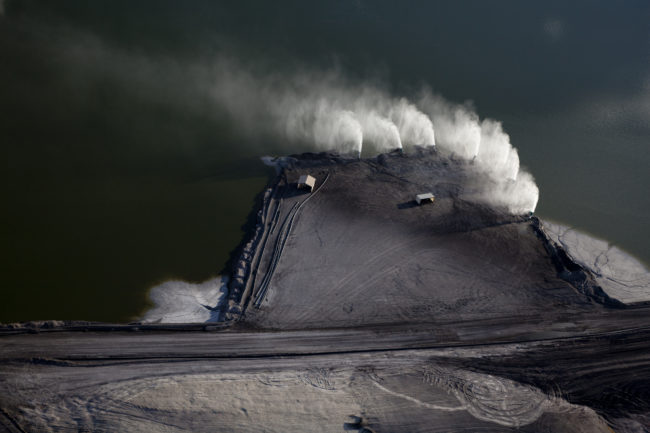by Anne Hedges
Westmoreland Coal Emerges from Bankruptcy
As Westmoreland Coal Co. emerges from bankruptcy, many important questions remain. The public still does not know who the new owners of the company are, nor anything about their ability and commitment to comply with mining, water, and reclamation laws. Westmoreland has three Montana coal mines. The smallest is a lignite mine that produces about 250,000 tons of coal each year. The mine serves a small coal plant (the Lewis & Clark Station – see below) near Sidney. The mine will close when the coal plant closes in 2020. The second mine is the mid-sized Absaloka mine on the Crow Agency. It produces about 4 million tons of coal a year. This mine will be given to the new owner along with Westmoreland’s third mine in the state, the very large Rosebud mine, which produces about 8.5 million tons of coal a year and exclusively serves the Colstrip power plant and a very small waste coal plant nearby. The Rosebud mine has caused significant water pollution and dewatering problems, yet the State is close to authorizing another enormous expansion of the mine, despite not knowing who the new owners will be.
Colstrip Power Plant Inches Closer to 2025 Closure Date

What happens when the owners of 40% of the Colstrip power plant owners are forced to stop utilizing the electricity from the plant in 2025? What happens when the owners of 70% are forced by their states to close the plant soon thereafter? Those are the questions facing all the Colstrip owners, and it arises due to legislative actions in Washington and Oregon. The Washington legislation has passed its Senate and is moving at breakneck speed through its House. It would require every Washington utility to stop providing coal-fired electricity to their customers by 2025. Three of the Colstrip owners operate in Washington. Meanwhile, Oregon, recovering from devastating wildfires, and with Democrats firmly in control of the legislature and governor’s office, is committed to passing a carbon “cap and trade” bill this session. Two of the Colstrip owners provide electricity to Oregon customers. Washington and Oregon are concerned about the environmental and climate change impacts of burning coal, and about the rapidly escalating costs. To both states closing Colstrip is justifiably part of their climate solution.
Lewis & Clark Coal Plant Will Close in 2020
Montana Dakota Utilities (MDU) announced that it will close the Lewis & Clark
coal-fired power plant in 2020. The filthy 50-megawatt plant was built in 1958 and burns lignite, the lowest grade of coal, and puts about 350,000 tons of carbon dioxide into the air each year. MDU said it will close the plant because “the old coal plants have become too expensive to operate.” According to MDU’s press release: “low-cost power available on the market, due to low-cost natural gas and increasing wind resources, as well as rising costs to operate these facilities, led to the decision to retire the coal plants.” Another one bites the dust!
DEQ Estimates $700 million for Colstrip Cleanup
The Montana Department of Environmental Quality (DEQ) recently told the Montana House Energy Committee that cleanup of the extensive contamination from the coal ash ponds at Colstrip could cost between $400 and $700 million. In recent months, DEQ has finally received $150 million in remediation bonds from the Colstrip plant owners to cover the eventual closure costs of the ash ponds and remediation for the least complex of the three coal ash disposal areas in need of cleanup. DEQ is still evaluating clean-up proposals and bond amounts for the coal ash ponds of units 1 and 2 and the largest and most complex contamination at the ash ponds for units 3 and 4. DEQ made these estimates based on estimates provided by the Colstrip owners, so the figure is likely to climb. The most recent clean-up proposal by the plant operator, Talen Energy, failed to propose cleanup of an ash pond that is sitting in the groundwater table. Talen’s proposal is not only laughable, it also violates federal clean-up requirements. With half-baked proposals such as this, clean-up costs could climb to one billion dollars in coming years.
Cryptocurrency Business to Buy Hardin Coal Plant?
The Hardin coal-fired power plant, a 115-megawatt plant just north of Hardin, has barely operated for the last several years because it sells its electricity on the open market, where electricity currently is very cheap. In early 2018, the plant owner said the plant would close by Spring if a buyer was not found. It did not close and now it appears to have a buyer – a cryptocurrency business. Cryptocurrency operations need an enormous amount of electricity to power the large computer systems that are necessary for this new international money business (such as bitcoin). Cooler northern states are the preferred locations because they require less air conditioning for the equipment. This puts Montana in the crosshairs of a financially volatile business – one that will contribute to climate change because of its enormous electricity demands. Time will tell how this business venture and the concept of cryptocurrencies will pan out, but for now the new owners appear determined to continue putting nearly a million tons of carbon dioxide into the air annually from a previously uneconomic coal plant.

